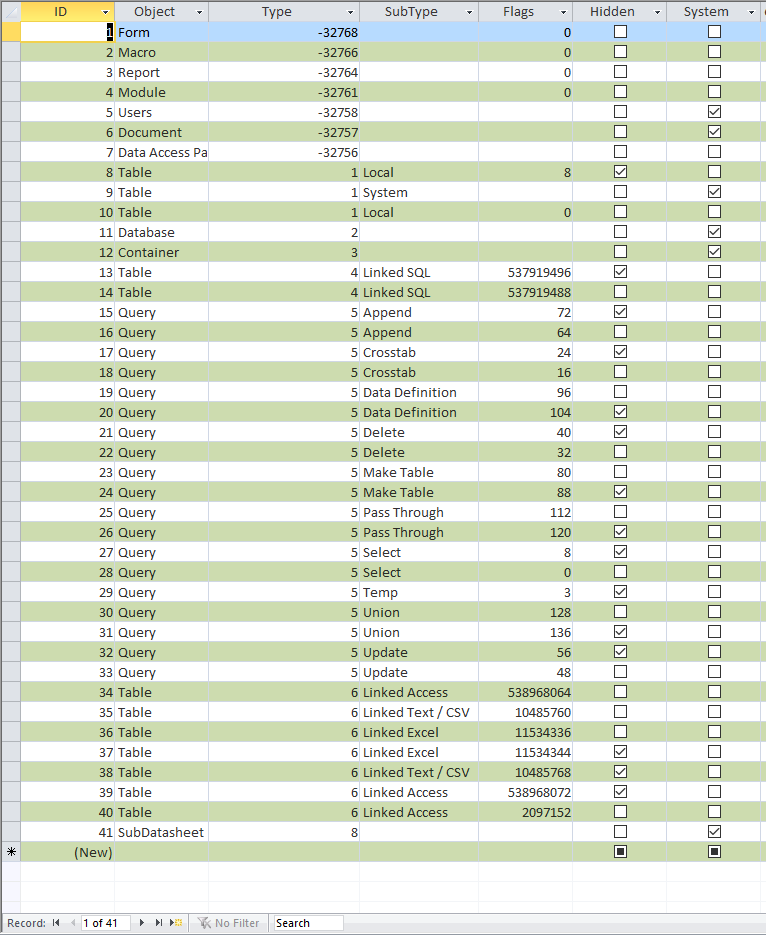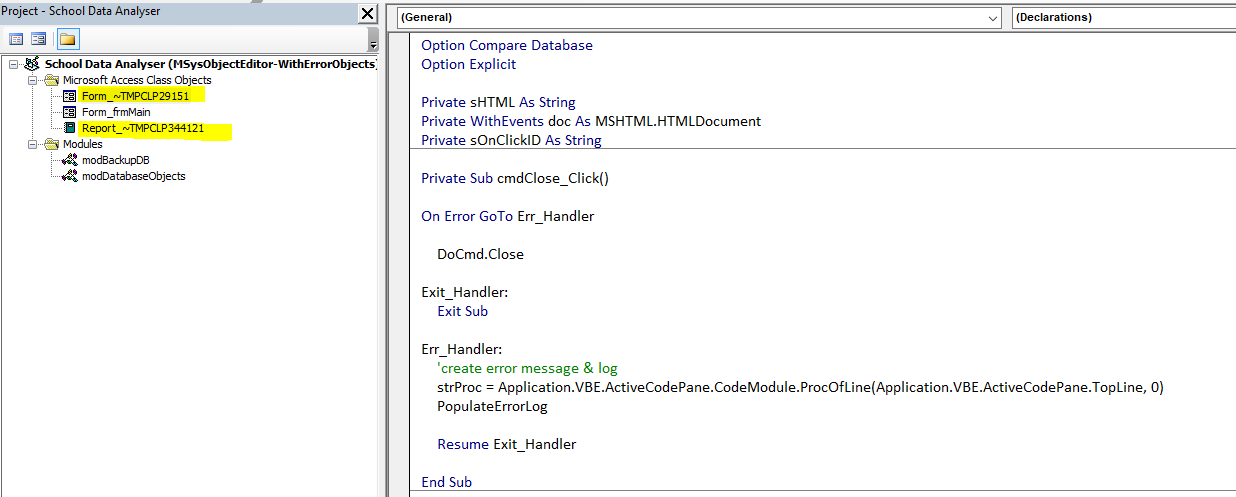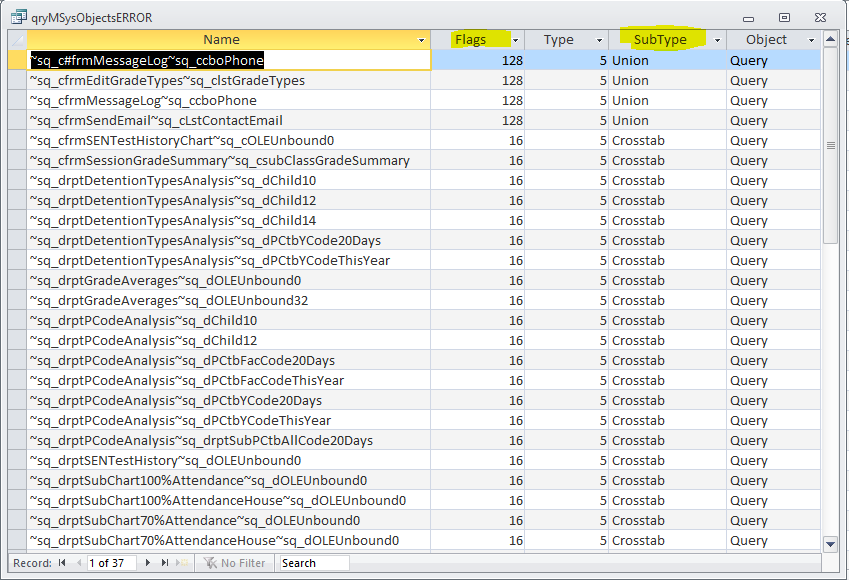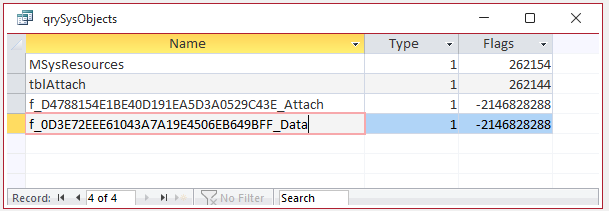First Published 16 May 2017 Last Updated 8 Mar 2025 Difficulty level : Moderate
UPDATED 8 Mar 2025: New section on 'expired' attached objects

Section Links:
~TMPCLP objects
Wrongly flagged objects
Extinct objects
Expired attached objects
Download
Feedback

NOTE: This is a companion to my newer article: Recover Deleted Database Objects
The read only system table MSysObjects keeps a record of all items in a database so these can be used by forms/reports/module code etc.
Each item is identified using a type value and a flag value
Fig 1: Reference table tblSysObjectTypes

Normally the MSysObjects table works perfectly but things can go wrong leaving incorrect data in the table e.g. if the database crashes for any reason after deleting an object.
If errors build up over time, I believe these may eventually make the database unusable.
In other words, don't ignore the problems as they won't go away!
NOTE:
It is important to remember that the MSysObjects table has been made deliberately difficult to edit.
This is to prevent users tampering without realising the potential consequences to their databases.
This article discusses 3 types of problem that can occur & a solution for each

1. ~TMPCLP objects
Return To Top
After a database object is deleted, Access keeps a copy in memory until the database is closed.
Deleted objects are renamed with a ~TMPCLP prefix. Compacting or closing the database SHOULD remove these.
However, if the database crashes for some reason before that has been done, the code for the object remains as a 'phantom' in the VBE as something like 'Form_~TMPCLP29151'
Fig 2: Deleted object and its code in the VBE

The object itself is of course no longer available or listed in the navigation pane.
The objects remain in the system table MSysObjects but (for safety reasons) this table cannot be directly edited
Running a compact/repair does NOT remove these 'phantom' items.
It is USUALLY possible to remove such objects using code like this:
DoCmd.DeleteObject acForm, "~TMPCLP21541"
However, the 'standard' solution is to create a new database & import all items from the original database.
The ~TMPCLP items are of course not transferred.
Although this works, it is time consuming if you have a large database.
I used to think there was no way of directly deleting the 'phantom' object code from the VBE. However, after some experimentation, I came up with 2 successful approaches :
a) Use a recordset to cycle through & delete the ~TMPCLP objects found.
First create a query qryMSysObjectsTMPCLP:
SELECT MSysObjects.Name, MSysObjects.Type
FROM MSysObjects
WHERE MSysObjects.Name Like '~TMPCLP*'
ORDER BY MSysObjects.Name;
Now use that query in the following procedure (stored in a standard module)
CODE:
Sub DeleteTmpClpObjects()
'===============================================
'Purpose : remove any leftover ~TMPCLP objects from the database
'Author : Colin Riddington - Mendip Data Systems
'Date : 30/04/2017
'===============================================
Dim Rs As DAO.Recordset
Dim strSQL As String
Dim N As Integer
Dim Q As Integer
On Error GoTo Err_Handler
'check for '~TMPCLP' objects
N = DCount("*", "MSysObjects", "MSysObjects.Name Like '~TMPCLP*'")
If N = 0 Then
MsgBox "There are no 'leftover' database objects named '~TMPCLP*" & _
vbNewLine & vbNewLine & _
"This routine will now close", vbInformation, "No TMPCLP objects"
Exit Sub
Else
If MsgBox("There are " & N & " 'leftover' database objects named '~TMPCLP*" & _
vbNewLine & vbNewLine & _
"Click OK to remove these objects from the database", _
vbExclamation + vbOKCancel, "Remove " & N & " TMPCLP objects?") = vbCancel Then Exit Sub
End If
If MsgBox("You should backup the 'front end' database BEFORE deleting these objects" & vbNewLine & vbNewLine & _
"Do a backup now? (RECOMMENDED)", vbExclamation + vbYesNo, "Copy the front end database?") = vbYes Then
CopyCurrentDatabase
End If
strSQL = "SELECT qryMSysObjectsTMPCLP.* FROM qryMSysObjectsTMPCLP;"
Set Rs = CurrentDb.OpenRecordset(strSQL)
Do Until Rs.EOF
Select Case Rs("Type")
Case 1, 4, 6 'tables
DoCmd.DeleteObject acTable, Rs("Name")
Case 5 'queries
DoCmd.DeleteObject acQuery, Rs("Name")
Case -32768 'form
DoCmd.DeleteObject acForm, Rs("Name")
Case -32764 'report
DoCmd.DeleteObject acReport, Rs("Name")
Case -32766 'macro
DoCmd.DeleteObject acMacro, Rs("Name")
Case -32761 'module
DoCmd.DeleteObject acModule, Rs("Name")
Case Else
'???
'look at what gets printed in the immediate window
'and include the type in the select case
Debug.Print Rs("Type"), Rs("Name")
End Select
Rs.MoveNext
Loop
Rs.Close
Set Rs = Nothing
'check again for '~TMPCLP' objects
Q = DCount("*", "MSysObjects", "MSysObjects.Name Like '~TMPCLP*'")
'end message
If Q = N Then 'none removed
MsgBox "None of the " & N & " 'leftover' database objects named '~TMPCLP*'" & _
" could be removed from the database", vbCritical, "TMPCLP objects were not deleted"
ElseIf Q = 0 Then 'all removed
MsgBox "All " & N & " 'leftover' database objects named '~TMPCLP*'" & _
" have been removed from the database", vbInformation, "TMPCLP objects successfully deleted"
Else 'partly deleted
MsgBox N - Q & " 'leftover' database objects named '~TMPCLP*'" & _
" have been removed from the database" & vbNewLine & vbNewLine & _
"However, " & Q & " '~TMPCLP' objects were not removed", vbExclamation, "TMPCLP objects partly deleted"
End If
Exit_Handler:
Exit Sub
Err_Handler:
MsgBox "Error " & err.Number & " in DeleteTmpClpObjects procedure :" & vbNewLine & _
" - " & err.Description, vbExclamation, "Error"
Resume Next
End Sub
NOTE:
The values in the select case statement refer to the object type code from the MSysObjects table
This approach worked perfectly & was very fast.
In a large db of about 5000 objects, 3 ~TMPCLP objects were found & removed in less than 2 seconds
For some reason, only one of these were shown in the VBE window
b) There is an even easier method if you want to avoid code:
Just replace the 'phantom' object with a real one! Amazingly this works!
Create a new form/report with the same name as the ~TMPCLP object
Save it and replace the existing form when prompted
Close the new form.
It is automatically deleted along with the ~TMPCLP item

2. Wrongly 'flagged' objects
Return To Top
All form & report items containing a row source are assigned their own record in the MSysObjects
table. These are identified as TEMP queries (type = 5 ; flag = 3).
The object name will look similar to these examples:
~sq_c#frmMessageLog~sq_ccboPhone
~sq_cfrmMessageLog~sq_ccboPhone
~sq_cfrmSendEmail~sq_cLstContactEmail
~sq_ffrmPStats3
~sq_rrptPRecordTeacherCrosstab
NOTE: ~sq_f = form ; ~sq_c = form control ; ~sq_r = report ; ~sq_d = report control
Access ignores these 'TEMP queries' in the query designer window
However, recently one of my databases, wrongly re-flagged some items as 'normal queries'.
As a result, these 'wrongly flagged' items appeared in the query designer window
Fig 3: ALL form/report row source objects SHOULD have flag value = 3. If not, these will incorrectly appear in the query designer

Fig 4: Query designer window error

I created another routine, similar to the first one, to remove these items
For this, another query qryMSysObjectsERROR is needed:
SELECT MSysObjects.Name, MSysObjects.Flags, tblSysObjectTypes.Type, tblSysObjectTypes.SubType,
tblSysObjectTypes.Object
FROM MSysObjects INNER JOIN tblSysObjectTypes ON (MSysObjects.Flags = tblSysObjectTypes.Flags) AND
(MSysObjects.Type = tblSysObjectTypes.Type)
WHERE (((MSysObjects.Name) Like "~sq_*") AND ((MSysObjects.Flags)<>3))
ORDER BY MSysObjects.Name;
Now use that query in the following procedure (stored in a standard module)
CODE:
Sub DeleteMSysErrorObjects()
'===============================================
'Purpose : remove any incorrectly flagged MSysObjects from the database
'Author : Colin Riddington - MendipData Systems
'Date : 12/05/2017
'===============================================
Dim Rs As DAO.Recordset
Dim strSQL As String
Dim N As Integer
Dim Q As Integer
On Error GoTo Err_Handler
'check for incorrectly flagged objects
N = DCount("*", "qryMSysObjectsERROR")
If N = 0 Then
MsgBox "There are no 'incorrectly flagged' database objects" & _
vbNewLine & vbNewLine & _
"This routine will now close", vbInformation, "No incorrectly flagged objects"
Exit Sub
Else
If MsgBox("There are " & N & " 'incorrectly flagged' database objects" & _
vbNewLine & vbNewLine & _
"Click OK to remove these objects from the database", _
vbExclamation + vbOKCancel, "Remove " & N & " incorrectly flagged objects?") = vbCancel Then Exit Sub
End If
If MsgBox("You should backup the 'front end' database BEFORE deleting these objects" & vbNewLine & vbNewLine & _
"Do a backup now? (RECOMMENDED)", vbExclamation + vbYesNo, "Copy the front end database?") = vbYes Then
CopyCurrentDatabase
End If
strSQL = "SELECT qryMSysObjectsERROR.* FROM qryMSysObjectsERROR;"
Set Rs = CurrentDb.OpenRecordset(strSQL)
Do Until Rs.EOF
Select Case Rs("Type")
Case 1, 4, 6 'tables
DoCmd.DeleteObject acTable, Rs("Name")
Case 5 'queries
DoCmd.DeleteObject acQuery, Rs("Name")
Case -32768 'form
DoCmd.DeleteObject acForm, Rs("Name")
Case -32764 'report
DoCmd.DeleteObject acReport, Rs("Name")
Case -32766 'macro
DoCmd.DeleteObject acMacro, Rs("Name")
Case -32761 'module
DoCmd.DeleteObject acModule, Rs("Name")
Case Else
'???
'look at what gets printed in the immediate window
'and include the type in the select case
Debug.Print Rs("Type"), Rs("Name")
End Select
Rs.MoveNext
Loop
Rs.Close
Set Rs = Nothing
'check again for incorrectly flagged objects
Q = DCount("*", "qryMSysObjectsERROR")
'end message
If Q = N Then 'none removed
MsgBox "None of the " & N & " 'incorrectly flagged' database objects'" & _
" could be removed from the database", vbCritical, "Incorrectly flagged objects were not deleted"
ElseIf Q = 0 Then 'all removed
MsgBox "All " & N & " 'incorrectly flagged' database objects" & _
" have been removed from the database", vbInformation, "Incorrectly flagged objects successfully deleted"
Else 'partly deleted
MsgBox N - Q & " 'Incorrectly flagged' database objects" & _
" have been removed from the database" & vbNewLine & vbNewLine & _
" However, " & Q & " 'incorrectly flagged' objects were not removed", _
vbExclamation, "Incorrectly flagged objects partly deleted"
End If
Exit_Handler:
Exit Sub
Err_Handler:
MsgBox "Error " & err.Number & " in DeleteMSysErrorObjects procedure :" & vbNewLine & _
" - " & err.Description, vbExclamation, "Error"
Resume Next
End Sub

3. 'Extinct' objects
Return To Top
I also found a number of items which were still in the MSysObjects table though the objects had already been deleted.
I identified these by checking for 'parent' objects no longer in the database
Fig 5: Extinct objects left in the MSysObjects table after the object has been removed. Compacting MAY delete these . . . but not always

A third routine was created to deal with these items.
This was slightly trickier to manage - but the following does work!
First create a query qryMSysObjectsTEMP:
SELECT MSysObjects.Name, IIf(InStr(Mid([Name],6),"~")>0, Mid([Name],6,InStr(Mid([Name],6),"~")-1),
Mid([Name],6)) AS ParentObjectName, MSysObjects.Flags, tblSysObjectTypes.Type, tblSysObjectTypes.SubType,
tblSysObjectTypes.Object
FROM MSysObjects INNER JOIN tblSysObjectTypes ON (MSysObjects.Flags = tblSysObjectTypes.Flags) AND
(MSysObjects.Type = tblSysObjectTypes.Type)
WHERE (((MSysObjects.Name) Like "~sq_*") AND ((MSysObjects.Flags)=3))
ORDER BY MSysObjects.Name;
Next create another query qryMSysObjectsEXTINCT:
SELECT qryMSysObjectsTEMP.Name, qryMSysObjectsTEMP.ParentObjectName AS EXTINCTParentObjectName,
qryMSysObjectsTEMP.Flags, qryMSysObjectsTEMP.Type, qryMSysObjectsTEMP.SubType,
qryMSysObjectsTEMP.Object
FROM qryMSysObjectsTEMP LEFT JOIN MSysObjects ON qryMSysObjectsTEMP.ParentObjectName =
MSysObjects.Name
WHERE (((MSysObjects.Name) Is Null));
Now use those queries in the following procedure (stored in a standard module)
CODE:
Sub DeleteMSysExtinctObjects()
'===============================================
'Purpose : remove any MSysObjects that are no longer in the database
'Author : Colin Riddington - Mendip Data Systems
'Date : 13/05/2017
'===============================================
Dim Rs As DAO.Recordset
Dim strSQL As String
Dim N As Integer
Dim Q As Integer
On Error GoTo Err_Handler
'check for MSys objects that are 'extinct' (no longer in the database)
N = DCount("*", "qryMSysObjectsEXTINCT")
If N = 0 Then
MsgBox "There are no 'extinct' database objects" & _
vbNewLine & vbNewLine & _
"This routine will now close", vbInformation, "No extinct objects"
Exit Sub
Else
If MsgBox("There are " & N & " 'extinct' database objects" & _
vbNewLine & vbNewLine & _
"Click OK to remove these objects from the database", _
vbExclamation + vbOKCancel, "Remove " & N & " extinct objects?") = vbCancel Then Exit Sub
End If
If MsgBox("You should backup the 'front end' database BEFORE deleting these objects" & vbNewLine & vbNewLine & _
"Do a backup now? (RECOMMENDED)", vbExclamation + vbYesNo, "Copy the front end database?") = vbYes Then
CopyCurrentDatabase
End If
strSQL = "SELECT qryMSysObjectsEXTINCT.* FROM qryMSysObjectsEXTINCT;"
Set Rs = CurrentDb.OpenRecordset(strSQL)
Do Until Rs.EOF
Select Case Rs("Type")
Case 1, 4, 6 'tables
DoCmd.DeleteObject acTable, Rs("Name")
Case 5 'queries
DoCmd.DeleteObject acQuery, Rs("Name")
Case -32768 'form
DoCmd.DeleteObject acForm, Rs("Name")
Case -32764 'report
DoCmd.DeleteObject acReport, Rs("Name")
Case -32766 'macro
DoCmd.DeleteObject acMacro, Rs("Name")
Case -32761 'module
DoCmd.DeleteObject acModule, Rs("Name")
Case Else
'???
'look at what gets printed in the immediate window
'and include the type in the select case
Debug.Print Rs("Type"), Rs("Name")
End Select
Rs.MoveNext
Loop
Rs.Close
Set Rs = Nothing
'check again for MSys objects that are 'extinct' (no longer in the database)
Q = DCount("*", "qryMSysObjectsEXTINCT")
'end message
If Q = N Then 'none removed
MsgBox "None of the " & N & " 'extinct' database objects'" & _
" could be removed from the database", vbCritical, "Extinct database objects were not deleted"
ElseIf Q = 0 Then 'all removed
MsgBox "All " & N & " 'incorrectly flagged' database objects" & _
" have been removed from the database", vbInformation, "Extinct database objects successfully deleted"
Else 'partly deleted
MsgBox N - Q & " 'extinct' database objects" & _
" have been removed from the database" & vbNewLine & vbNewLine & _
"However, " & Q & " 'extinct' database objects were not removed", _
vbExclamation, "Extinct database objects partly deleted"
End If
Exit_Handler:
Exit Sub
Err_Handler:
' If Err <> 5 And Err <> 3071 And Err <> 2498 Then
MsgBox "Error " & err.Number & " in DeleteMSysEXTINCTObjects procedure :" & vbNewLine & _
" - " & err.Description, vbExclamation, "Error"
' End If
Resume Next
End Sub

4. 'Expired' attached objects
Return To Top
Access 2007 introduced three new complex datatypes: multivalued fields , attachment fields and column history memo fields.
Each of these has features that may seem initially appealing (especially to new Access developers).
However, they all have major disadvantages and most experienced Access developers, including myself, recommend avoiding their use completely.
See the three articles linked above for more details on each of these complex datatypes.
When a table is created with a complex datatype field, Access automatically creates a separate deep hidden attached table used to manage the data in the complex field.
Similarly, for linked complex tables, Access automatically links the attached table.
If a table has more than one complex field, a separate deep hidden attached table will be created for each of those fields
The attached tables cannot be viewed directly by any standard method. This built-in protection is designed to ensure the tables cannot easily be tampered with.
The use of hidden attached tables obscures effective data management, making it more challenging to directly access and manage the normalized data.
The attached table names start with 'f_' followed by a long string then another underscore and (usually) the complex field name.
For example: f_D4788154E1BE40D191EA5D3A0529C43E_Attach
The screenshot below shows two tables with attachment fields together with the hidden attached tables associated with each

Exactly the same structure applies to tables with multivalued fields, each of which require a separate deep hidden attached table.
When a complex field or table is deleted, Access will normally automatically delete any attached tables as there are no longer required.
However, tables with column history memo fields each have two deep hidden attached tables:

a) The table named f_ . . . _VersionHistory_ . . . contains the version history data. It is automatically deleted when the column history table is deleted.
b) The table named MSysComplexType_ . . . is ALWAYS empty and I have been unable to determine its purpose.
More importantly, this table becomes detached and is left behind as an orphaned table when the column history table is deleted.
Due to the nature of the table, it appears to be impossible to remove it.
I reported this issue to the Access team in Jan 2025. They acknowledged it as a bug . . . and that it has existed ever since Access 2007 was released 18 years ago!
Hopefully it will be fixed at some point, but as the table is deep hidden and always empty, it is highly unlikely to be a priority issue for the Access team.

5. Download
Return To Top
Click to download an example application which includes all 3 routines:
MSysObjectEditor-WithErrorObjects Approx 1.1 MB (zipped)
I've deliberately left several of each type of error in the db so you can test out the routines for yourself.
There are 30 items in the MSysObjects table of which 17 are errors to be removed. After running all 3 routines, you will be left with just 13 valid items
I've also included 4 images. Please copy these to the same folder as they are referenced in the main form of this application
If you wish to use the routines in your own databases, copy the following items:
a) table tblSysObjectTypes
b) all 5 queries starting with qryMSys ...
c) module modDatabaseObjects
d) module modBackupDB - only needed if you want to use my backup routine CopyCurrentDatabase
NOTE:
BEFORE running any of these routines in your own applications, it is STRONGLY recommended that you make a copy of the front-end database - just in case!
I have included a backup routine CopyCurrentDatabase to do this (or you can use your own backup code if you prefer - modify the code if so...)

6. Feedback
Return To Top
Please use the contact form below to let me know whether you found this article interesting/useful or if you have any questions/comments.
Also, do let me know if you find any bugs in the application.
Please also consider making a donation towards the costs of maintaining this website. Thank you
Colin Riddington Mendip Data Systems Last Updated 8 Mar 2025

|
Return to Access Articles Page
|
Return to Top
|